Kalyvia, Attica. (2020)
Following on the heels of Ethos, his first look at rural Greek traditions and their relations to costume, photographer George Tatakis has trained his sights on ceremonial costumes worn by women in various communities. The project, titled Caryatis, has been a few years in the making, during which Tatakis has crisscrossed the archipelago. However, he is not ready to exhibit it yet as he feels it still needs fine tuning.
Ethos was your first project, which entailed travelling around Greece making costume-related images. How did you map your route around the country?
I am from an area that currently doesn’t belong in Greece, because my ancestors came during the Lausanne Treaty in 1923, when they exchanged populations with Turkey. So we were Greeks that were living in the Black Sea region of today’s Turkey. Three generations before me, we are from Athens, so I don’t have a village in Greece with which I am very familiar.
Ethos occurred naturally because I really like the small remote villages of rural Greece. I like the architecture. I wanted something to photograph so as to visit these places, but when I started I didn’t have the budget to stay two months or longer. I figured that if I visited the place during one of the traditional events, usually two to four days, that would be more interesting for me: when the village is celebrating and they are all out, wearing their costumes.
How would you know what was happening where?
 Delvinaki, Pogoni, Epirus. (2020)
Delvinaki, Pogoni, Epirus. (2020)
We know some famous events that happen around Easter in Greece, but other than that, I found some customs that are not famous at all, like in adjacent villages where events would be hosted. I researched on the internet, cross-checking information from videos, images and other sites. Some were failures and others a success.
Even though the costumes are prominent, the landscapes and the interiors are just as dominant. What was your thinking around balancing all of these elements?
I have a lot of influences in composition. I have my hero photographers like [Henri Cartier-]Bresson and [Josef] Koudelka, Constantine Manos and Nikos Economopoulos, Magnum photographers, all of them. I had some inspiration from that. But, otherwise, I believe a good photo is a combination of good subject matter and composition. The environment is integral in defining your subject.
Regarding the interiors and costumes, global folklore tradition also dictates the ownership of things. Whatever we use is not ours. In that sense, for Greek people, it’s very difficult to sell their ancestral homes, for example. You have the obligation to pass it on to the next generation. Same with costumes: you can have one costume that four or five generations have contributed to making.
Ethos doesn’t have as much of a singular focus on costumes as Caryatis does. What, for you, was the underlying thread?
 Volax, Drama, Macedonia. (2019)
Volax, Drama, Macedonia. (2019)
The ambassadors of tradition in Greece — they are usually people of low aesthetic quality. They are in the local cultural clubs, usually. They mostly keep the club to make parties, drink coffee and gossip. They are old people who cannot communicate with today’s generation, but are trying to pass on tradition. I’m trying to portray it in a way that communicates with today’s generation — or any generation, for that matter.
Caryatis seems more grand and deliberately orchestrated.
Yes, I was directing the entire scene: finding the environment, the person; asking them to pose for me; trying to use whatever I find on the scene as props, which I reorchestrate to create what I like.
After working on Ethos for some years I had an exhibition at the Benaki Museum in Athens. Because of that I had another exhibition in France, the Fragonard Museum.
What happened was because those guys are the biggest perfume manufacturers in France, they wanted to keep the images from Ethos that had female costumes, because they relate to perfume. That gave me the idea to photograph traditional female costumes in Greece, which has a huge number of these costumes and not one single place of referencing all of them.
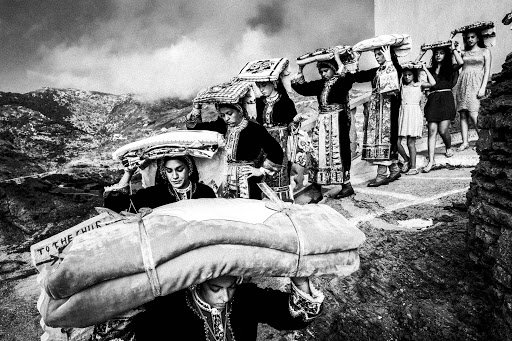 Olympos, Karpathos Island. (2016)
Olympos, Karpathos Island. (2016)
The other bit is that until that point, I had demonised orchestrating pictures. I thought that I should be making snapshots of real-life moments. But I went to London and saw the work of Alex Prager, an American photographer. She makes photographs that are very elaborate and staged, but when I saw the exhibition I didn’t know that the photos were staged. I was very impressed with how she found the scenes to photograph.
Immediately, I started thinking about why I demonised these photos. After all, the thing is to be able to communicate your thoughts with the person who sees the image. So I decided to start working on directed photographs, where I could control every last detail.
Looking at the scale of the work, it seems as if you visited a number of places in a short space of time. How did that influence the dynamics of the shoots?
What became more important for me was the relationship with the people who are the production, should I say. I usually find people who teach traditional dances, or are residents of local cultural clubs.
Most of the time, it is people who are dance teachers. These people have the authority to call any of their students and ask them to wear the clothes, or make pictures of the costumes.
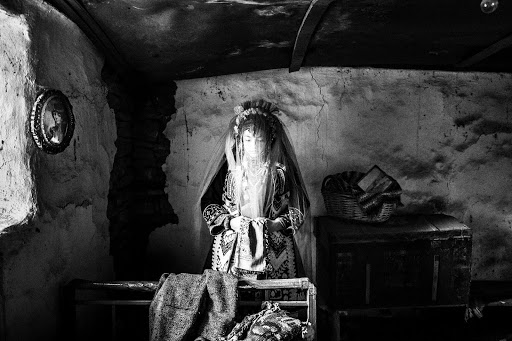 Isaakion, Evros, Thrace. (2020)
Isaakion, Evros, Thrace. (2020)
The relationship with the model is usually made on set. Sometimes I’ll see the model two or three times, but most of the time, it’s in the place we are going to make the photograph.
The thing with me is that I’ve always loved visual art. I started with drawing and painting, but I didn’t have the passion to create something in so many hours. I wanted to create the images in my mind fast, and that was photography for me.
It usually takes me a short time to find the right place and the right model. That’s why the models are comfortable with me directing them, because I don’t have them posing for hours and I’m not shooting in machine-gun mode. I take four or five photos and that’s it.
How much travelling do you still have to do for the Caryatis project?
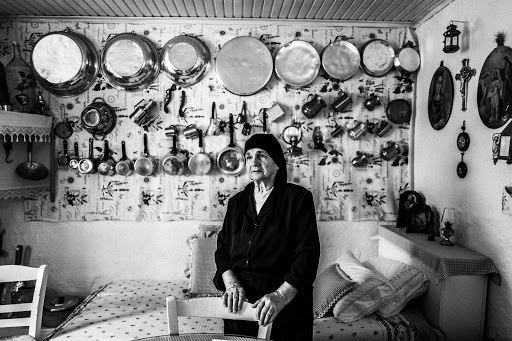 Anogia, Crete. (2017)
Anogia, Crete. (2017)
I’ve been everywhere, really, but Caryatis is not finished yet. I now have a private sponsor who is helping me with travelling for when we are back on the streets and the quarantine ends. I will do a more methodical approach to swipe the whole Greece and hopefully find all the available costumes in Greece and photograph them. So far I have been everywhere: from Thrace to Crete …
How does the viewer understand the history of what they are seeing, given your minimalist captions?
I think that’s a whole different matter, because what I’m trying to give to people is the inspiration to look for these things. From the caption, you can see the costumes are Greek. It’s then easy for you to find information about costumes. Because the images are black and white, parts of your imagination are already working with the image.
Your images often have a dream-like quality, can you talk about your technique?
I shoot in digital and the images come in colour because I am shooting raw. But then it’s my post-processing that creates this black-and-white feel. I think post-processing is like reading out loud your poem … taking the photograph [is] like writing the poem but then if you want to communicate with people, that’s what post-processing does; that creates that distinct feeling.
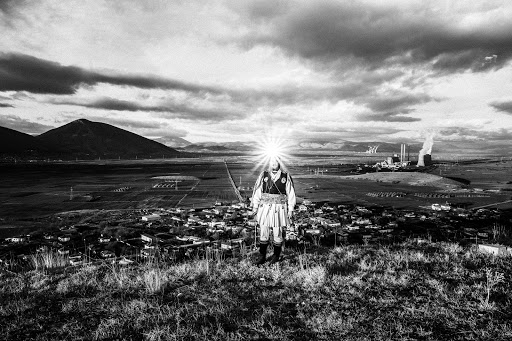 Tetralofos, Kozani, Macedonia. (2017)
Tetralofos, Kozani, Macedonia. (2017)
For me the most important thing is before, if you are going for a distinct look in your work. What’s most important is the use of light in my images. I’d say I prefer side light, but there is no certain rule.
Lighting a scene comes with experience and many things generally contribute in deciding how to do so. I’ve been helped by my experience in drawing. It’s very important for a photographer because it’s easier to understand how shadow and light work. My experiences in the darkroom have also given me a good sense.
But apart from that, you have influences of what you have seen in your life. I have some influence on lighting from paintings by Caravaggio and by Rembrandt and by El Greco. If you see paintings by Caravaggio you’ll see the relevance in lighting with my images. Other than that, I’m quite bold in my post-processing. I don’t give importance to burn[ing] highlights or to dismiss shadow details. I process the image to where I feel good looking at it.
What do you think it says about the society if most of the people in costumes are elderly or middle-aged?
There are places in Greece that have stronger traditions and there you see younger people taking part as well. Also you see places with more fun traditions: there you also see younger people. When there is a lot of fun, drinking and dancing, it attracts more people. If it’s more ritualistic, usually you see more older people.
The other thing is, older people have some qualities related to tradition, and these qualities are that they understand these traditions better. Let’s say, you have a local event in the village — everyone takes part. The children and teenagers go into it because of its bizarre or fun aspects.
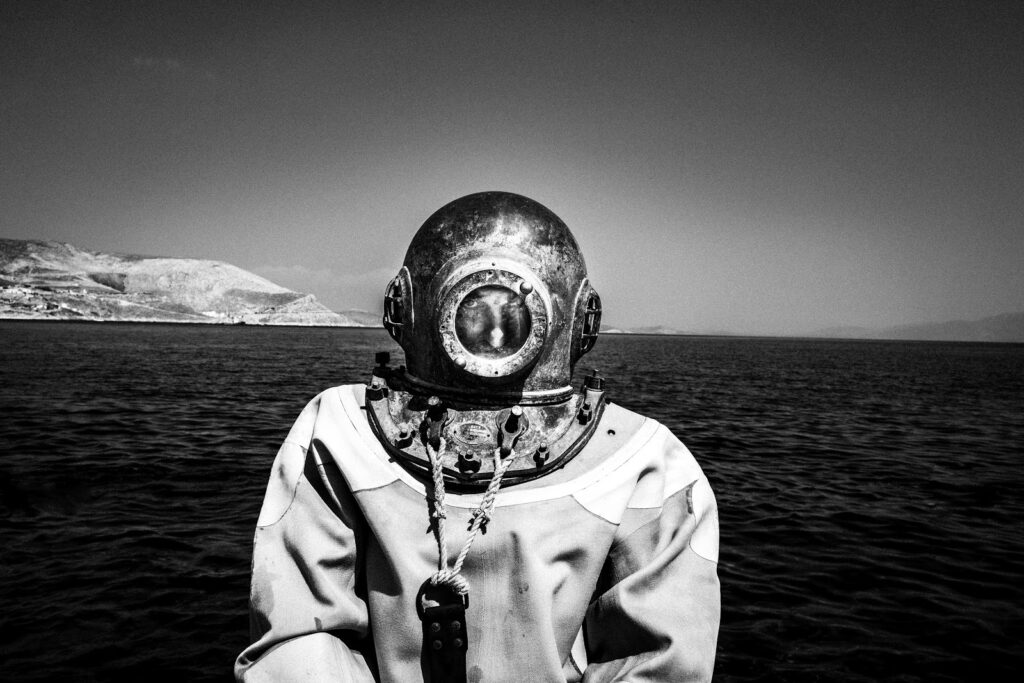 Kalymnos Island, Greece. (2018)
Kalymnos Island, Greece. (2018)
But as the years pass they understand it more. The older people pay more attention to detail. They’ll have costumes that are made better, will be more expensive, or more rich costumes, so they are the more significant participants of those events in most cases.
Where are you exhibiting this work?
Cannes was just an introduction. But this year we have the Greece 2021 committee, which is celebrating 200 years since the Greek Revolution
— maybe we will do an exhibition this year. I have another proposal from the Fragonard Museum, the one they are building in Arles. But because of the coronavirus I’m not even sure whether they are finished constructing the museum.
I’m not sure what’s next, but I still feel I have a lot of work to do to finish Caryatis. If I make a big exhibition of it, I’ll feel like this project has come to an end and it’s time to move on and I don’t feel like it yet.
For more of George Tatakis’s images, visit: tatakis.com